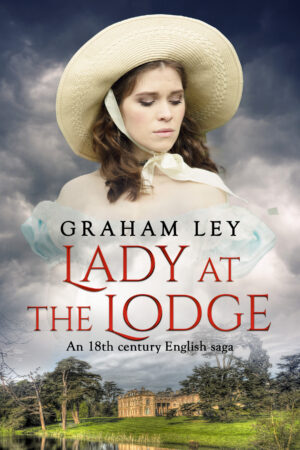Interview with Graham Ley
1 April 2024

We are delighted that you could join us to talk about your new release. Could you tell us a little more about it? Lady at the Lodge, published last December, is the third in a series of books about the Wentworth family, who are Anglo-Breton and live in Devon. The novels are set in 1795 and 1796, and involve espionage and intrigue, and the love stories of many of the characters on both sides of the Channel. This latest, Lady at the Lodge, picks up on the attempted revenge on two young women of the family, Amelia and Arabella, by a renegade militia officer, who contrives to abduct them. It also continues the search by young Gilles in Brittany for his father, and his passionate involvement with a refugee from the plantations of Saint-Domingue. I have just completed writing the final novel in the saga.
What was the inspiration behind your book? What prompted you to tell this story? Historical period and landscape: my characters very definitely live in a landscape, and perhaps grow out of it, and out of the times in which they live. When I started to visit Brittany over twenty years ago I knew almost straight away that it was an inherently wonderful landscape for storytelling, with its ancient stone-and-timber manor houses and chateaux, and its fascinating way of life. But as a West-countryman in some large part, I could not get Devon out of my bloodstream; so combining both regions across the Channel in a turbulent time became the core of an plot. That led to the idea of a family that was half English, half Breton, and to a period of war between France and Britain that contained intrigue, danger and romance, and at the heart of the saga an enduring mystery about birth and inheritance.
How long did the book take to write? How much re-writing do you normally do? These novels have taken about six to nine months to write, with the inevitable planning that goes in advance of that, and some weeks putting the pieces of the novel finally together. I found with the first book that I had introduced a relatively wide range of characters while concentrating on the major love interest between two of them. So it became obvious that there would be a sequel tracing the stories of those who had stood back in the first, which starts you off well. Part of all that came from the two interlinked settings for the action, in Devon and Brittany, each with their own characters, and the cross-over between them.
I know authors vary wildly in how they go about their work: I favour a broad plan and a good sense of direction, and I then lay things out in greater detail before each chapter. I wrote a lot of non-fiction for my living before turning to novels, so I do have a relatively reliable day-to-day writing discipline, which is all the more pleasant because now I can spend my days with characters who worry, hope, and have warm and passionate feelings. I always work carefully over the previous day’s draft making adjustments before I go on to the next sequence, so when it comes to the full typescript I find that I have less to do.
Where did your research for the book take you? For this latest, to the old wharves in London, where what they call the ‘stairs’ down to the river still exist, and to the roads and the heath in Hampstead, where Amelia Wentworth is staying – both of these places feature ominously in the abduction. But I also tread the streets of Hatherleigh and Okehampton in Devon, locating the old coaching inns, along with the twisting lanes and the villages. Buildings matter a great deal: they have corridors and panelled chambers, and occasionally old stables, while in Brittany it is a pleasure to wander round the old ruelles of towns like Pontivy and Auray, or to come across medieval manors that suddenly pop up out of the surrounding countryside, little changed from their medieval origins. I have found too that old maps can soon begin to picture a town for you as it once was, which you can then piece together from surviving remains, or from watercolour sketches, prints and engravings: old Plymouth is like that. I like to write realistically enough for readers to be able to trace the action on the ground – in Devon, Brittany, or London – if they feel moved by curiosity or a spirit of adventure!
Without giving too much away, what was the hardest part of the book to write? Undoubtedly anything to do with any kind of trauma, either as it happens, or the aftershocks of it. As an author, you have to live it imaginatively to write about it emotionally, but also work hard to be something other than just harshly traumatic for your readers. Much of the Wentworth saga is about how events resonate and may come to shape lives, or restrict them, and I do wonder at times if we are not all affected and in part deeply disturbed by some of the things that have happened to us.
When did you realise that you wanted to be an author? Well, I remember that there was a period when I was travelling on trains for my job, and then also slogging home from work, and I felt by that stage of my life thoroughly exhausted. What came into my mind, in a rather visionary kind of way, was the sense of relief I would feel if only I could be telling stories – I suppose that I see writing fiction as almost a ‘live’ event, with the reader right in front of me. I began to scale back on work drastically, and started to write a few children’s stories, while the memory of what our child was like at those ages was still fresh. And the path to writing a novel came through memories of my mother’s work, so historical romance was my inevitable choice.
If you could give your younger writing self any advice, what would it be? I suppose for any younger writer it would be making up your mind what it is you want to write – is it the literary review novel, or are you really attracted to genre? Coming to it later in life I was never in any doubt, since I wanted above all to write a tribute novel, and that meant historical romance. But looking back on that experience, I would say that a secondary consideration is trying to decide how your idea for the novel stands: is it the first of a possible series featuring the same characters and basic concept; or the beginning of a longer story of several books which – perhaps unfortunately – conventionally goes under the name of a ‘saga’; or a stand-alone, to be followed by a completely different idea and characters in your next book? I started writing a saga without knowing it, and the major problem there is that readers may have to wait a while for each sequel!
Can you tell us what you are working on now? That is not so difficult, because it is the fourth and final book in the series, with the title Mistress of the Manor. Writing it has been an exciting and challenging task, because this novel has to pull together all the threads and storylines and resolve some of the remaining mysteries, leaving most of the characters satisfied and hopefully many of the readers too. After all, where would the story be without a masquerade ball, and a climactic struggle at night on the beach at Cuckmere Haven? Fortunately, I have nearly finished it in draft, so hopefully it will come along to conclude the saga without much delay.

About the Author
Graham Ley was born in north London into a family of journalists and writers, and started to read popular fiction when he was a teenager, picking up on regency romance from his mother, Alice Chetwynd Ley. After a career spent teaching theatre in London and overseas, Graham came to live in Devon twenty-five years ago, close to where his grandmother grew up. Since then, he has also spent much time in Brittany with his family, getting to know and love the region and its history. When he decided to write his first novel, The Baron Returns, he chose to set his story in 1795, at the time of the Breton rebellion against the revolutionary regime in Republican France. Further novels in this series known collectively as the Wentworth Family Saga have followed, published as ebooks and paperbacks by Sapere Books.
Graham has previously written and edited non-fiction, plays and drama translations, and children’s stories, and is now delighted to be back in the atmosphere in which he grew up.
The Baron Returns, Heir to the Manor, and Lady at the Lodge in the Wentworth Family Saga are published by Sapere Books, in ebook and paperback, and available via the Amazon pages (links below).
Author website/blog: https://grahamley.com
The Baron Returns – https://shorturl.at/zIRZ9
Heir to the Manor – https://shorturl.at/dprGX
Lady at the Lodge – https://shorturl.at/fkFP9



